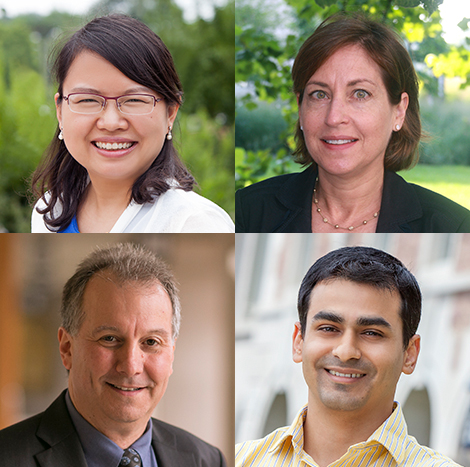Four new professors join School of Engineering & Applied Science
Professors Aaron Bobick, Hong Chen, Rohan Mishra and Lori Setton bring expertise in human-robot collaboration, materials science and biomedical engineering

Four new faculty members will join the School of Engineering & Applied Science for the 2015-16 academic year, bringing the total faculty number to 87. The addition of the new faculty continues the school's goal to reach 100 faculty members by 2020.
Hong Chen, assistant professor
About: Chen joins the faculty as an assistant professor of biomedical engineering in the School of Engineering & Applied Science and of radiation oncology at the School of Medicine from Columbia University, where she is a postdoctoral research scientist in the Department of Biomedical Engineering.
Education: Chen earned a doctorate in biomedical engineering from the University of Washington in 2011, and bachelor's and master's degrees from Xi'an Jiaotong University in Shaanxi, China, in 2003 and 2006, respectively.
Research: Chen's research focuses on physical acoustics, therapeutic ultrasound and ultrasound imaging. She plans to set up an ultrasound-based, image-guided therapy laboratory to translate basic research advances in medical ultrasound into medical devices that can impact patient care. Her goal is to develop the ultrasound-based image-guided drug delivery platform for cancer therapy through combining the functions of ultrasound, integrating physical acoustics with the development of medical ultrasound devices and bridging basic and translational research.
Lori A. Setton, professor
About: Lori A. Setton joins the department as the Lucy and Stanley Lopata Distinguished Professor of Biomedical Engineering from Duke University, where she was the William Bevan Professor of Biomedical Engineering and Bass Fellow and associate professor of orthopaedic surgery. She joined the Duke faculty in 1996. Previously, she held several positions at Columbia University. She is a fellow of the Biomedical Engineering Society and of the American Institute of Biological and Medical Engineering and earned a Presidential Early Career Award from Scientists and Engineers (PECASE) in 1997, as well as many other awards.
Education: Setton earned master's and doctoral degrees, both in mechanical engineering and biomechanics, in 1988 and 1993, respectively, from Columbia University. She earned a bachelor's degree in mechanical and aerospace engineering from Princeton University.
Research: Setton's research focuses on the role of mechanical factors in the degeneration and repair of soft tissues of the musculoskeletal system, including the intervertebral disc, articular cartilage and meniscus. In the lab, her work focuses on engineering and evaluating materials for tissue regeneration and drug delivery. She combines engineering and biology to determine the role of mechanical factors to promote and control healing of cartilage.
Aaron Bobick, professor
About: Bobick joins the School of Engineering & Applied Science as dean and the faculty as professor of computer science from the Georgia Institute of Technology, where he was professor and founding chair of the School of Interactive Computing. Prior to joining the Georgia Tech faculty, he served as a member of the MIT Media Laboratory faculty, where he led the Media Lab Defense Advanced Research Projects Agency (DARPA) Video Surveillance and Monitoring Project, as well as its Dynamic Scene Analysis research effort.
Education: Bobick earned bachelor's degrees in mathematics and computer science and a doctorate in cognitive science from the Massachusetts Institute of Technology (MIT).
Research: Bobick's research focuses on action recognition by computer vision. He is the author of more than 80 academic papers on this subject alone and has recently extended his research to robot perception for human-robot collaboration. Bobick served as director of the Georgia Tech Graphics, Visualization and Usability Center, an internationally known research center in computer vision, graphics, ubiquitous computing and human-computer interaction.
Rohan Mishra, assistant professor
About: Mishra joins the faculty from the Oak Ridge National Laboratory in Oak Ridge, Tenn., where is a guest scientist and a postdoctoral scholar through Vanderbilt University. Previously, he was a fellow of the Center for Emergent Materials at The Ohio State University.
Education: Mishra earned a doctorate in materials science and engineering from The Ohio State University in 2012 and a bachelor's degree in technology from the National Institute of Technology Karnataka in Surathkal, India in 2008.
Research: In his lab at WashU, Mishra plans to identify and develop a quantitative measure of structure-property correlations in materials, such as epitaxial thin films and materials with reduced dimensionality, using a synergistic combination of scanning transmission electron microscopy and atomic-scale theory, to create rational design of materials with properties tailored for electronic, magnetic, optical and energy applications.
Click on the topics below for more stories in those areas
- Research
- Biomedical Engineering
- Computer Science & Engineering
- Mechanical Engineering & Materials Science



